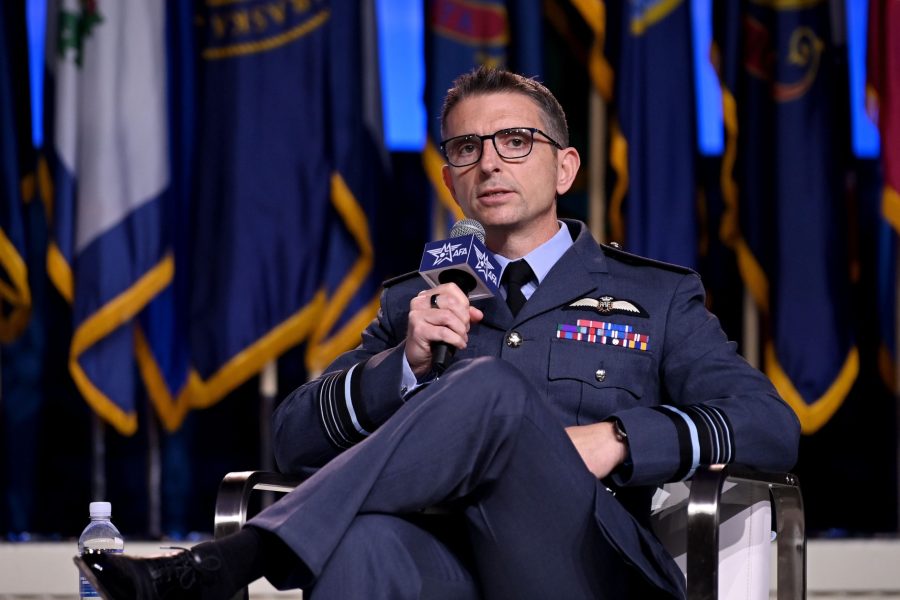NATIONAL HARBOR, Md.—The Space Force has established a task force to envision its forthcoming Space Futures Command, but plans are still murky and the new command is still months from standing up.
A day after the Air Force announced a provisional Integrated Capabilities Command at AFA’s Air, Space & Cyber Conference, Space Force leaders said they are still in the midst of their analysis on how to structure its forward-looking Space Futures Command, which in many ways will be a counterpart to ICC.
Department leaders announced their intent to create a Space Futures Command in February, a fourth field-level command that would combine its Concepts and Technology Center, a Wargaming Center, and the the Space Warfighting Analysis Center, and tasked with tackling fundamental questions about the long-term needs and capabilities required of the U.S. Space Force.
But while that basic vision hasn’t changed, Chief of Space Operations Gen. B. Chance Saltzman said Sept. 17 that the definitions and structure underlying that vision are still in the formative stages in the hands of a small team he called “Task Force Futures.”
“We pulled people that were taking on some of the activities around the force—whether they were doing wargaming, whether they were doing force design, there’s some personnel from SWAC that do data analytics, and we tried to pull a smattering of a cross-functional team together, and they perform mission analysis,” Saltzman told reporters. “So it’s a very small team, less than a dozen people at this point. They’re just trying to ask the right questions, frame the discussion so they can see what resources are going to be necessary.”
Led by Lt. Gen. Shawn Bratton, the Space Force’s chief planning officer, the task force recently held a tabletop exercise to examine how best to organize the command.
“The tabletop exercise was just almost an opportunity to see OK, how does the flow of data go through Futures Command?” he said. “How do you go from key questions into how it might be documented as a contributing element to our objective force. Who has to do what? How do we use wargames? How do we use experimentation? Are there demos? Do we need acquisition authorities? Do we need capabilities developers? Is this all about strategy? How do we infuse intelligence, the intelligence apparatus of the service, into those efforts?”
From exercises like that, Saltzman added, the task force will craft requirements for Space Futures Command—authorities, manning, and processes it needs. But while other Space Force leaders previously said Space Futures Command could reach an initial operational capability before the end of 2024, Saltzman indicate a more deliberate pace.
“We’ve identified a team to get us to initial operating capability, and they’re going to make it happen, if not by the end of this year, I guarantee you within a year,” he said during his keynote address. Asked about it later during a press conference, he told reporters that “what we want to focus on is putting things in place based on key milestones for effectiveness … [rather than] a time trigger.”
The new Space Futures Command has the advantage of pulling exisiting elements and personnel together, rather than building everything from scratch, as Bratton has noted in the past. The SWAC exists, as does Space Delta 10, which handles doctrine and wargaming. Yet that is still no small feat, said RAF Air Marshal Paul Godfrey, the first assistant chief of space operations for future concepts and partnerships. Godfrey has firsthand experience—he was the first commander of the U.K. Space Command when it started in 2021.
“We’re kind of building the plane as we’re flying it already, because the SWAC is already out there,” Godfrey said. “The Wargaming Center is already out there. So actually from my own experience of standing up a command in the United Kingdom, which brought together a couple of extant areas … I think the priority will be trying to get the mechanism up and running.”
Godfrey suggested the new command may be “undermanned” to start, even if the total manpower required is relatively small.
“There aren’t that many new people required,” he said. The Concepts and Technology Center is new, but the Space Warfighting Analysis Center already exists and “when you talk about the Wargaming Center, that’s currently there with Delta 10,” Godfrey added. “So actually, the personnel budget is reasonable. There’s a headquarters element, as well, so all those elements will be about 600 or so personnel.”
Futures Command will have to work closely with other field commands and military space organizations to be effective, but those dependencies mean it should also be be a powerful connector—and money-saver—for the Space Force.
“It does become the front door, I think, for allies and partners to go and understand where they can contribute, where they can add value to the United States, where we can ultimately build what’s termed an objective force … that actually has allied capabilities integrated into it,” said Godfrey, whose assignment on Saltzman’s staff itself symbolizes the kind of close international partnerships the Space Force envisions with allies.
“When we do our force design … it’s one thing to say we’re going to need this much SATCOM in our objective force,” Saltzman said. “But if you say, ‘Well, hold on, what can the UK bring? What can the French bring? What can the Germans bring, or the Australians and Canadians bring?’ And if we understand—knowing that if we’re going to be in a large-scale conflict with our coalition of partners that then we’ll have access to these capabilities—we can produce a more insightful force design that maybe doesn’t [need to] buy resources that we can get from other nations.”
